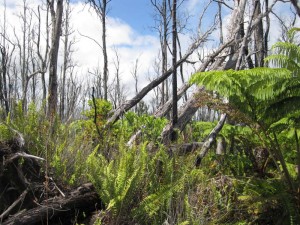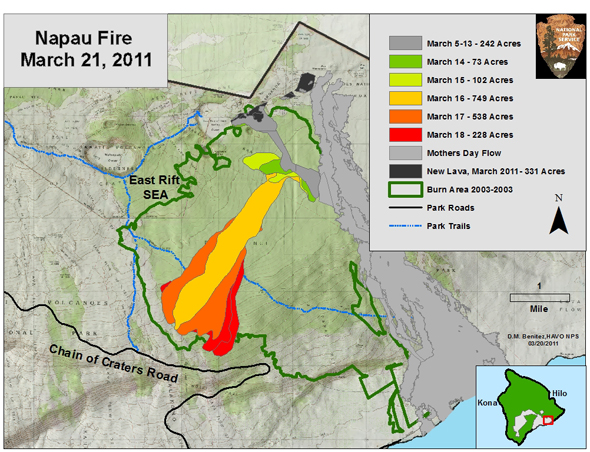 Media release | Hawaii Volcanoes National Park
Media release | Hawaii Volcanoes National Park
Fire Overview: Napau Fire Start Date – March 5, 2011, / (Lat/Lon: 19⁰ 22’29” x 155⁰ 7’ 25”; el. 2450). The fire area has received rain in the last 48 hours, which slowed the fire’s growth. However, pockets of high heat remain on the fire front, and the north and south flanks of the fire. Flames were visible along the south flank. Monday, helicopter operations were shuttling crews and equipment into the fire area to begin mop-up of hot spots. Approximately 1,924 acres have burned, and there is no estimated containment date. The Napau Fire is approximately seven miles southeast of the Kilauea Visitor Center, located on the east rift of Kilauea Volcano. It is a lava caused wildfire resulting from the March 5, 2011, Kamoamoa Fissure Eruption.
Strategy: Firefighters began cooling and mop-up operations along the north flank of the fire perimeter after establishing secure safety zones. Standing dead trees, snags, pose a high hazard safety issues to firefighters. The north flank has the greatest potential to threaten the east rift Special Ecological Area. Fire engines are patrolling the Chain of Craters Road and near the front of the fire. Planning strategy continues to focus on scouting, monitoring (i.e. fuel samples) and exploring all suppression options. The fire will continue to burn under the influence of radiant heat generated by the lava flow and high winds pushing the fire down slope. Sulfur dioxide gas from volcanic vents increases the vegetation mortality which has been already stressed from the drought of 2010.
Values to be protected: A high priority fire protection goal is the east rift Special Ecological Area (SEA), which has been intensively managed to exclude invasive species and protect and restore highly valued native plant and animal communities. Protected over decades by Hawai’i Volcanoes National Park, the rain and mesic forests threatened by the spread of the Napau Fire are home to plants, birds, bugs, spiders, and bats found only in Hawai’i. They include the endangered Hawaiian bat (`ope`ape`a) Hawaiian hawk,(`io) and other uniquely Hawaiian plants and animals such as Hawaiian thrush, (`oma`o), lama and sandalwood trees, happyface spiders, carnivorous caterpillars, and Hawaiian honeycreepers (`apapane and `amakihi). National park and USGS Hawaiian Volcano Observatory (HVO) infrastructures, monitoring equipment, and other visitor features near the fire are also being protected.
Fire Resources: Hawai`i Volcanoes National Park firefighters are being augmented with NPS fire crews from Whiskeytown National Recreation Area, Olympic NP, and the USDA Forest Service (Eldorado, Sequoia, Stanislaus and Los Padres National Forests in CA.); 27 firefighters and management staff are committed. Other fire resources and specialists are arriving from the mainland Tuesday.
Air and Smoke: Trade winds returned today from an easterly direction with less rain and lower relative humidity over the fire area. Light smoke is visible along the Chain of Craters Road. In addition to smoke, air quality is constantly monitored in regards to sulfur dioxide emissions from volcanic activity. Fire managers will continue to coordinate fire efforts with USGS HVO scientists regarding eruption activity and air quality.
Closures: The Chain of Craters Road has been re-opened, March 20, 2011. However, a change in fire activity could cause temporary closures.
Partners Involved: US Geological Survey Hawaiian Volcano Observatory and USDA Forest Service.


by Big Island Video News10:38 pm
on at
STORY SUMMARY
Media release | Hawaii Volcanoes National Park Fire Overview: Napau Fire Start Date – March 5, 2011, / (Lat/Lon: 19⁰ 22’29” x 155⁰ 7’ 25”; el. 2450). The fire area has received rain in the last 48 hours, which slowed the fire’s growth. However, pockets of high heat remain on the fire front, and the […]